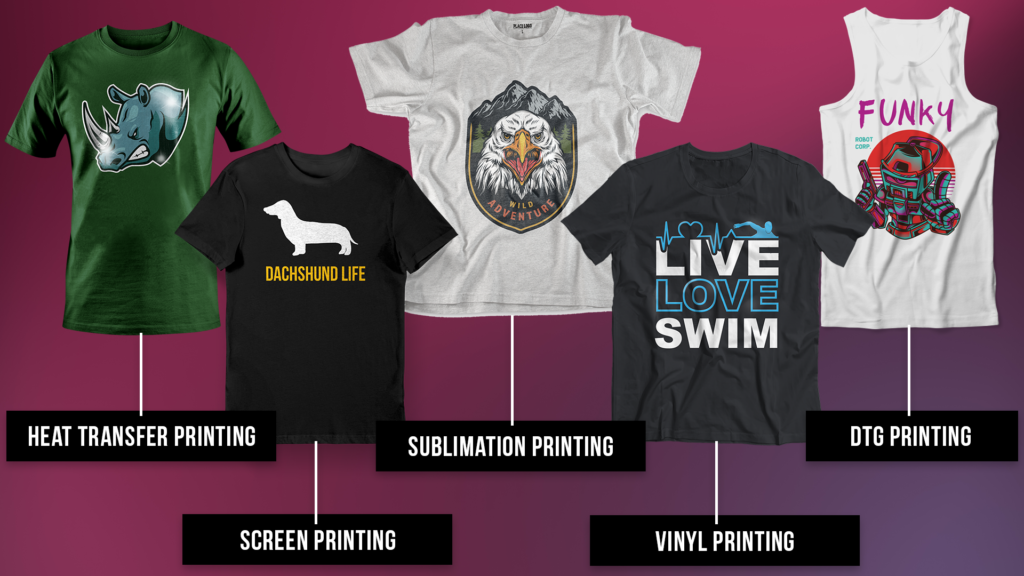T-shirts are one of the most popular fashion items, worn by people of all ages, genders, and backgrounds around the world. Their wide appeal comes from the ability to personalize them through various materials, printing techniques, branding, and styles. In this article, we explore the most significant T-shirt printing techniques along with their pros and cons.
Key Factors to Consider Before Choosing a T-Shirt Printing Technique
- Compatibility with Different Fabrics
Not every printing method works well with all fabrics. For example, using dye sublimation on thick cotton can ruin the shirt. Each technique has its ideal fabric types, so it’s essential to verify compatibility before starting. - Speed of Production
If you need a large quantity of shirts quickly, opt for a method that supports mass production. Each technique typically indicates whether it’s suited for single or bulk orders. - Cost
Printing costs can vary widely. Some methods are more budget-friendly than others. If you plan to implement certain techniques at home, factor in the price of necessary equipment and supplies.
Popular T-Shirt Printing Techniques
1. Screen Printing
Description: Known for its durability and high-quality results, screen printing (or silkscreen printing) is a preferred method for mass production.
How It Works: A stencil is created on a mesh screen, which is then used to apply ink to the fabric. The process allows for repeated use of the stencil for consistent results.
Who It’s For: Best for large runs of the same design, especially single-color designs.
Pros:
- High quality and durability
- Efficient for large quantities
- Fast results for single designs
Cons:
- Not ideal for small orders
- Complex for intricate designs
- Requires significant setup time
2. Dye Sublimation
Description: This method is perfect for large, vibrant designs and works best on polyester fabrics.
How It Works: The dye is transferred onto a special paper and then sublimated onto the fabric using heat, resulting in a design that becomes part of the fabric.
Who It’s For: Ideal for all-over prints and unique, multicolored designs.
Pros:
- Excellent for large designs
- Unlimited color possibilities
- Durable prints
Cons:
- Limited to light-colored fabrics
- Can be costly for small batches
- Doesn’t fully cover seams or armpits
3. Direct to Garment (DTG)
Description: A newer method that works like a traditional printer, DTG allows for intricate designs and is suitable for small quantities.
How It Works: A specialized printer directly applies ink onto the garment, providing a soft touch.
Who It’s For: Great for startups needing small orders with varied designs.
Pros:
- Easy to use for intricate designs
- Soft finish on fabric
- Flexibility in design changes
Cons:
- High initial investment for quality printers
- Slower for large quantities
- May not produce vibrant colors on dark fabrics
4. Heat Press Printing
Description: Similar to dye sublimation but uses transfer paper, this method is well-suited for small batches.
How It Works: The design is printed onto transfer paper, which is then heat-pressed onto the fabric.
Who It’s For: Perfect for individuals or small businesses creating custom designs.
Pros:
- Economical for small quantities
- Simple process
- High-quality reproduction
Cons:
- Not suitable for dark materials
- Requires careful temperature management
- Slower than some other methods
5. Vinyl Cutting
Description: This technique involves cutting designs from vinyl and applying them to fabric, commonly used for logos and small designs.
How It Works: A CAD cutter creates the design from vinyl, which is then heat-pressed onto the fabric.
Who It’s For: Excellent for both small and large quantities, especially for intricate logos.
Pros:
- Versatile for various quantities
- Vibrant colors
- Durable and flexible designs
Cons:
- Requires specialized cutting equipment
- Limited to small designs
- Can reduce fabric flexibility
6. Spray Printing
Description: A more artistic approach, spray painting allows for unlimited design options.
How It Works: Fabric paint or spray is applied directly to the shirt, offering creative freedom.
Who It’s For: Ideal for artists or hobbyists seeking unique pieces.
Pros:
- Highly customizable
- Cost-effective for small projects
- Fun and engaging process
Cons:
- Variable design quality
- Less durable results
- Not suitable for mass production
7. Glow-in-the-Dark Printing
Description: These prints appear white in daylight but glow in the dark, adding an exciting element to T-shirt designs.
How It Works: Similar to screen printing but with special inks that provide the glow effect.
8. Foil Printing
Description: This trendy technique involves applying metallic foil to the fabric for a glitzy finish.
How It Works: Adhesive glue ink is printed on the fabric, and foil is pressed onto the design, adhering to the glue.
9. All-Over Printing
Description: This technique covers the entire shirt, including seams and edges, for a unique look.
How It Works: Fabric is printed before being cut and sewn into a T-shirt, allowing for designs that wrap around the garment.
10. Embroidery
Description: While not a printing method, embroidery adds a luxurious touch and is often used for logos and branding.
Benefits: Enhances the garment’s quality and provides a premium feel.
Conclusion
Selecting the right T-shirt printing technique is essential for achieving the desired aesthetic and durability. Each method has unique advantages, from the resilience of screen printing to the vibrant colors of dye sublimation. Understanding these techniques allows you to make informed decisions tailored to your design requirements and production needs. Whether you’re a startup or an established brand, choosing the appropriate printing method will help your T-shirts stand out in a competitive market.

